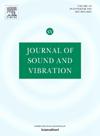A multi-modal and configuration-dependent chatter prediction approach for a milling robot
IF 4.3
2区 工程技术
Q1 ACOUSTICS
引用次数: 0
Abstract
In robotic milling for aerospace large and complex cabin structural components, chatter can significantly impair the surface quality of workpieces, and in severe cases even result in tool damage. To mitigate chatter-related issues, the selection of appropriate process parameters using Stability Lobe Diagrams (SLDs) is a widely employed and effective strategy. Nevertheless, most prior investigations have primarily focused on regenerative chatter in specific robotic configurations, often disregarding the impact of low-frequency chatter originating from the inherent structural modes of the robot and its configuration-dependent dynamics. A novel approach for predicting the multi-modal stability of milling robots across their entire workspace is presented in this study. By integrating multibody dynamics model and regenerative chatter theory, this approach comprehensively accounts for the vibrations of the robotic milling system, which encompasses both the robotic structure and the tool, as well as the influence of multi-order modal variations. Moreover, a new representation method for the stability cloud map is suggested. Utilizing the multibody system transfer matrix method, a dynamics model is formulated to accommodate alterations in configurations. Additionally, a grid-based dynamic parameter identification method is proposed to predict frequency response functions under different robotic configurations. The chatter stability prediction model is integrated with the dynamics model to establish a multi-modal driven SLD. Finally, the correctness of the proposed robotic dynamics model and the effectiveness of the multi-modal SLDs with variable configurations are validated through modal and milling experiments conducted on an industrial robot.
求助全文
约1分钟内获得全文
求助全文
来源期刊

Journal of Sound and Vibration
工程技术-工程:机械
CiteScore
9.10
自引率
10.60%
发文量
551
审稿时长
69 days
期刊介绍:
The Journal of Sound and Vibration (JSV) is an independent journal devoted to the prompt publication of original papers, both theoretical and experimental, that provide new information on any aspect of sound or vibration. There is an emphasis on fundamental work that has potential for practical application.
JSV was founded and operates on the premise that the subject of sound and vibration requires a journal that publishes papers of a high technical standard across the various subdisciplines, thus facilitating awareness of techniques and discoveries in one area that may be applicable in others.
 求助内容:
求助内容: 应助结果提醒方式:
应助结果提醒方式:


